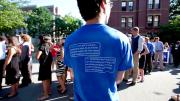“Harvard indifference”? It was hard to find on a flawless September 1 as the College inaugurated a new tradition: a celebratory Freshman Convocation for the entering class of 2013 that adapted some of the rituals of Commencement to welcome 1,672 first-years into their new community. “You came to us as individuals, you processed in as dorms, and you adjourn today as a class,” promised Kia McLeod ’10, vice president of the Undergraduate Council, as she and council president Andrea Flores ’10 formally presented the 2013 banner to their newest constituents, the most socioeconomically and racially diverse first-year class in College history.
The freshmen had gathered at 4 p.m. outside their dorms, most in high spirits and many in the requested “business casual” attire. At 4:15, summoned by the Memorial Church bell, they processed into Tercentenary Theatre, filing between cheering rows of Crimson Key Society members in bright red T-shirts and peer advising fellows in pale blue—participants in the two student groups most involved in helping first-years find their literal and figurative way around campus. The Harvard Band greeted them with fight songs before shifting to “Fair Harvard” as student leaders ushered a procession of House masters, other faculty members, and University leaders, most in academic gowns, onto the terrace beside Memorial Church for the 4:30 ceremony.
Welcoming the “fourth College class of ’13,” dean of freshmen Thomas A. Dingman offered a little history and the assurance that even when it comes to traditions, “opportunities for reinvention” exist. Dean of the College Evelynn M. Hammonds noted that her audience was beginning its college career under a new academic calendar, with a new General Education program, in a University facing unforeseen economic challenges, but told them not to limit their own expectations of what they could find and accomplish: another Harvardian, she reminded them, had challenged the country to go to the moon not because it was easy, but because it was hard—a test of the nation’s ability. Dean of the Faculty of Arts and Sciences Michael D. Smith, in his remarks, led the freshmen on a brief, virtual tour of the Yard, focusing on inscriptions and insignia, including a declaration at Canaday—“To travel hopefully is a better thing than to arrive”—and the veritas motto on the University’s shield. “Veritas is an open book,” he told them. “You will, each of you, help write it.”
President Drew Faust promised the class that it would give the number 13 a “whole new connotation.” It’s natural to feel “self-conscious and even a little uneasy” when starting something new, she acknowledged; unexpected points of view should be expected “in others, as well as in yourself.” The Harvard community is here, she told the first-years, to help them leave their comfort zones and free the part “that is willing to fail,” so that ultimately their idea of success in life will include an understanding of the role of failure—the most important message, she said, that she could convey. At the same time, she urged them to take time to explore, “to lose yourself in the infinite and sometimes uncharted world of Harvard’s libraries and museums” and the many other opportunities the College offers, and even to “sometimes not listen to us.” The class of 1913, she assured its successors, turned out just fine.
Reinvention of the traditional convocation ceremony began last April, first envisioned by director for freshman programming Katie Steele. Helped by “intrepid Harvard historian” (in Dingman’s words) Renny Little ’55, Courtney Shurtleff, director of College alumni programs for the Harvard Alumni Association (HAA), and intern Ashley Kaupert ’12, she refashioned the start-of-term public greeting of freshmen by the president and deans, an attendance-optional orientation-week event, into this year’s more formal yet festive occasion, a mandatory but welcoming foretaste of the Commencement morning observances four years ahead that will usher the class as seniors into the real world. Almost a hundred alumni, from different classes, states, and even countries—including HAA president Teresita Alvarez-Bjelland ’76 (from Norway) and senior representatives Stanley Niebruegge ’50 (New Hampshire), and Frances O’Leary ’54 (Cambridge)—were invited to help out and showed up to join the celebrations, sporting “Alumni Marshal” pins to match the “Class of 2013” pins distributed to the freshmen as a gift from the HAA.
Watching his charges mass cheerfully on the Widener Library steps for their first class photo, Tom Dingman said the ceremony had achieved “what upperclassmen have told us they wanted: a little more pomp and circumstance and ritual.” He grinned and added, “And now the upperclassmen are asking, ‘Can’t we have a do-over, with something like this for us?’"













